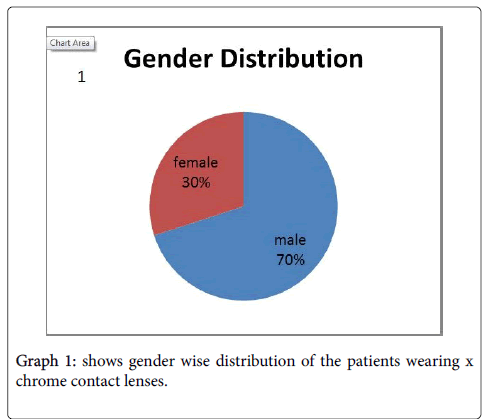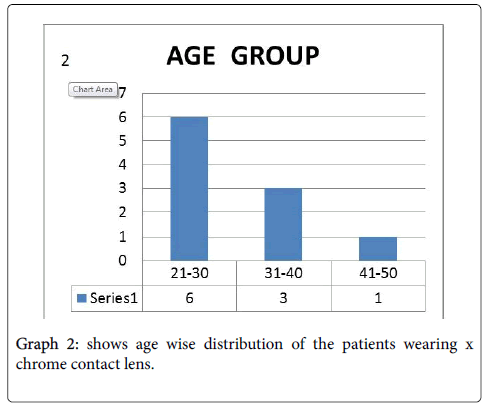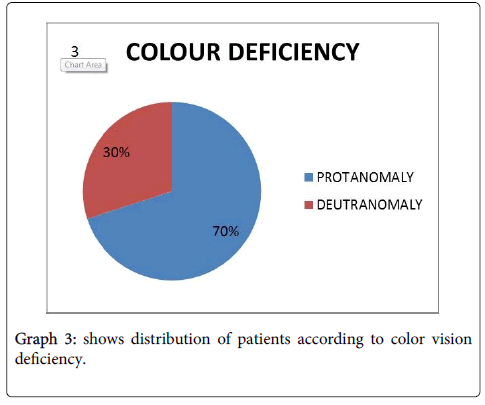Functional Vision with X Chrome Lenses
Received: 02-Oct-2017 / Accepted Date: 01-Nov-2017 / Published Date: 05-Nov-2017 DOI: 10.4172/2476-2075.1000125
Abstract
Purpose: To implement x chrome lens in children
Methods: A pilot, cross sectional study was performed in the tertiary eye centre during the period of 1 year. Functional vision like Visual Acuity, Contrast Sensitivity, Stereopsis and color vision of 10 existing x chrome soft contact lenses users were analyzed with and without lenses.
Results: Visual functions were compared statistically using paired t test with SPSS 20 software. Negligible change observed in visual acuity and contrast sensitivity with p value of 0.015 and 0.010 respectively. No change is observed in stereopsis. Ishihara shows normal color vision with x chrome lenses while D-15 test shows reduction in severity of color vision deficiency.
Conclusions: If X chrome color contact lenses are implemented during child’s learning period, it will eliminate many of the academic challenges that are faced with color coded learning and teaching materials and improve their quality for many recreational activities.
Keywords: Pediatrics; Color vision; X chrome contact lens
Introduction
X chrome is a color coded contact lens, worn monocularly in non-dominant eye. It mainly works on congenital protan and deuteran deficiency. It alters the psychological trivariables of color deficiency. Color vision deficiency is broadly divided into two parts: Inherited color vision deficiency and acquired color vision deficiency. According to Dalton, colour deficiency occurs due to vitreous discolouration, but this misconception has been abolished after post-mortem of his eye. Generally colours are seen due to 3 cone cells which are present at macular area. Red, Green and Blue cone cells are responsible for color. In congenital cases, protan and deuteran deficiencies occur while in acquired, tritan deficiency will occur [1]. This lens acts on inherited colour deficiency only. It temporary eliminates partial color vision deficiency and allows the patient to differentiate between colors. The main aim of this study is to implement this lens in pediatric population so that they can start learning to assess colors since childhood and their academic carrier will not be hampered due to color coded study materials.
Methodology
A pilot, cross sectional study was performed in the tertiary eye care centre during the period of one year. A total no. of 10 patients was enrolled in the study with informed consent. Patients having inherited color vision defect, using x chrome color contact lens, and absence of any ocular or systemic pathology were included into the study. Patients having acquired color vision defect, color vision defect due to diabetes or any sort of ocular pathology specially which can affect the study were excluded from the study.
Visual function was assessed with and without lens in all 10 patients. Visual acuity was measured using Log mar chart, Contrast Sensitivity was measured using Pelli Robson Contrast Sensitivity chart, Stereopsis was, measured using Titmus fly test, Color vision was assessed with ishihara plates and Fransworth Munsell-D-15 test [2].
Results
Graph 1 shows gender distribution. Out of 10 patients 7 were male. Graph 2 shows age wise distribution of the patients. Maximum patients using this lens were in the age group of 21-30. Graph 3 shows distribution according to color vision anomaly. 7 patients were having protanomaly and 3 patients were having deuteranomaly. Table 1 shows mean and p value of visual functions with x chrome lenses. Statistical analysis was performed using paired t test due to its normal distribution curve with SPSS software version 20. Mean value and standard deviation of visual acuity are 0.05 and 0.166 respectively with P value=0.155 which is less than 0.05 shows that there is no significant change in visual acuity with x chrome contact lens wear. Mean value and standard deviation of contrast sensitivity are 0.07 and 0.057 respectively with p value of 0.010 shows that there is no significant change in contrast sensitivity with x chrome contact lens wear. There is no change observed in stereopsis. With lens, protanomaly and deuteranomaly shows normal colour vision by Ishihara test.
| Visual acuity | Contrast sensitivity | Stereopsis | Colour vision | |
|---|---|---|---|---|
| Mean | 0.07 | 1.77 | 40 sec of arc | Normal |
| P value | 0.155 | 0.01 |
Table 1: shows mean and p value of visual functions with lenses.
Ishihara test which shows protanomaly and deuteranomaly without x chrome lens shows normal color vision with x chrome lenses. Fransworth-Munsell-D-15 test shows reduction in color deficiency but not complete elimination of deficiency.
Discussion
X chrome colour contact lens is a monocular lens worn in non-dominant eye. It is theorized that binocular individuals wearing one lens send new and possibly confusing information to brain. Through the process of retinal rivalry, information from the each eye is alternated such that a new perception of colour discrimination is observed by an individual [3]. Colour confusions have a variation of lightness. If wavelength of green pass through it they become darker and with red wavelength lighter. If a colour deficient wears a red lens and views object of red and green colour, the green portion will look darker than the red, so that previously blended two colours will be visible separate.
In this study, 10 existing x chrome lens users were taken and their visual function like visual acuity, contrast sensitivity, color vision and stereopsis is evaluated with and without lenses. According to Statistical analysis, binocularly negligible change is observed in visual acuity as well as contrast sensitivity with p values of 0.0155 and 0.010 respectively. So, if this lens is prescribed in childhood only, rather than in elder group, patient will get easily adapted and academics problems can also overcome with the prescription of this lens in pediatric age group.
References
- Paul L. Pease (2006) Borish’s Clinical Refraction. William J. Benjamin Second ed: 296- 352
- Ali. Colour Correction Lenses (also called as Dyslexia lenses or X Chrome lenses) (Therapeutic) Soft Contact Lenses.
Citation: Partha HC, Brinda HS (2017) Functional Vision with X Chrome Lenses. Optom Open Access 2:125. DOI: 10.4172/2476-2075.1000125
Copyright: © 2017 Brinda HS, et al. This is an open-access article distributed under the terms of the Creative Commons Attribution License, which permits unrestricted use, distribution, and reproduction in any medium, provided the original author and source are credited.
Share This Article
Recommended Journals
Open Access Journals
Article Tools
Article Usage
- Total views: 7650
- [From(publication date): 0-2017 - Feb 22, 2025]
- Breakdown by view type
- HTML page views: 6767
- PDF downloads: 883



